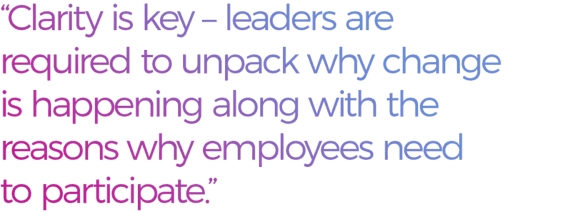We’ve discussed Change Management before, along with various aspects that need attention when undertaking it. Here, we’ll look at Change Management through the lenses of WNDYR’s Thinking Framework. We’ll also explore how those implementing change need to acknowledge the effects of their efforts on leadership, processes and systems, and individual employees.
Let’s dig in!
What is Change Management?
Change Management is a systematic approach to dealing with the transition or transformation of an organization’s goals, processes, or technologies. It prepares, equips, and supports individuals to successfully adopt change in order to drive organizational success and outcomes.
In other words, the purpose of Change Management is to implement strategies for effecting change, controlling change, and helping people to adapt to change. If employees do not adopt the change, the implementation of new systems will likely have little success.
Change Management and Leadership
Change, in general, is demanding. With that said, any change effort or shift in strategy that appears unstable or poorly thought-out is especially likely to incur significant resistance from employees and even taint the reputations of their Leadership. Both of these affects organizational health in the long run.
As a leader of a company or team undergoing organizational changes, you should be able to sufficiently answer the question, “What’s the rationale behind our change?”
While this question seems simple enough to answer, many leaders struggle. Unfortunately, doing so means many of teammates won’t comprehend the rationale behind Change Management efforts—or their leader’s strategies in general.
Fundamentally, clarity is key—leaders are required to unpack the rationale of why a change is happening along with the reasons why employees need to participate. More so, leaders have to be clear concerning the why, while giving employees a clear view of the rationale behind their decisions.

The Process of Change
Change Management efforts overwhelmingly affect Processes and Systems. Although it may seem daunting, plotting out the process of the change to come is a crucial factor in whether adoption of the new system is successful or not.
Having your approach clearly laid and planned out allows you to measure:
- how well your processes allow for planning and testing change
- how well your team is communicating around change
- how effective your system is in scheduling and implementing change efforts
- the efficiency of your process for documenting change
- the success of evaluating its effects
These processes provide insights into what efforts are effective by being measurable. Critically, it also reveals what might be lacking while providing clear avenues for individuals to provide feedback and raise concerns.
Individual Change Management
Last, but not least, is the Individual component of our Thinking Framework.
Considering Change Management from an Individual lens revolves around understanding the ways people generally experience change and the strategies they employ to adapt to these changes successfully. Unless proactive support and guidance are present through the changes the projects bring, embracing change is up to chance.
Additionally, having knowledge of what helps people make successful transitions is paramount.
Disciplines like psychology, for example, offer insights and frameworks from which teams can apply action to drive individual change.
Essentially, Change Management removes the failed adoptions and chance by providing employees with the preparation, support, and skills they need to succeed in change.
However, it’s up to the individuals themselves to take responsibility for their attitude towards change, ensure they complete the tasks assigned by their Change Management consultant, and recognize when they need to speak up and ask for help.
A New Perspective
Change Management is an essential approach for any organization as they set off on their digital transformation journey.
Unpacking Change Management efforts is easier with WNDYR’s Thinking Framework. By assessing the Individual, Leadership, and Processes and Systems lenses, teams can successfully identify and address all aspects of change.
Our solution designers and implementation consultants can help you rethink the way your teams do work. Contact us to find out more.